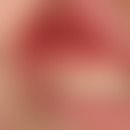Synonym(s)
HistoryThis section has been translated automatically.
Demarquay 1845
DefinitionThis section has been translated automatically.
Van der Woude syndrome (VWS) is an autosomal dominant inherited developmental disorder characterized by fistulas of the lower lip and cleft lip and/or palate (CL / P, CP). It is the most common cleft syndrome.
You might also be interested in
EtiopathogenesisThis section has been translated automatically.
The syndrome is caused by a frameshift mutation in IRF6.
ClinicThis section has been translated automatically.
Levy (1962) found deformities of the lower lip in members in 3 generations of a family. Two siblings had a cleft palate in addition to the lip abnormality. It is possible that in some affected families the syndrome is expressed only as a cleft lip due to the variable expression of the gene. Baker (1964) reported affected members in 3 generations who had cleft lips as the only malformation.
The rule that cleft palate alone and cleft lip with or without cleft palate behave differently does not apply to this disorder, in which either the type of cleft palate alone or the 2 in combination can occur. Janku et al. followed the Van der Woude syndrome over 7 generations. In 88% of those affected, cleft lip occurred as the most common manifestation. In 64% they were the only manifestation of the syndrome. The combination of cleft lip and palate occurred in 21%. Penetrance was 96.7%.
The main features of Van der Woude's syndrome are cleft lips and cleft lip with or without cleft palate or cleft palate (alone) (OMIM 119540). Since none of these features are present in all mutation carriers, some individual or familial VWS cases, especially those without cleft lip, cannot be distinguished from non-syndromal CL / P (OMIM 119530).
LiteratureThis section has been translated automatically.
- Birnbaum S (2008) Mutation screening in the IRF6 genes in patients with apparently nonsyndromic orofacial clefts and a positive family history suggestive of autosomal-dominant inheritance. Am J Med Genet 146A: 787-790
- Janku P (1980) The van der Woude syndrome in a large kindred: variability, penetrance, genetic risks. On J Med Genet 5: 117-123
- Levy J (1962) Twins in a family with lower lip malformation. Acta Genet Extra Med 12: 33-40
- Ranta R et al (1983) Correlations between microforms of the van der Woude syndrome and cleft palate. Cleft palate J 20: 158-162
- Ural A et al (2019) Van der Woude Syndrome With a Novel Mutation in the IRF6 genes. J Craniofac Surg 30:e465-e467.
- van der Woude A (1954). Fistula labii inferioris congenita and its association with cleft lip and palate. On J Hum Genet 6: 244-256
Disclaimer
Please ask your physician for a reliable diagnosis. This website is only meant as a reference.




